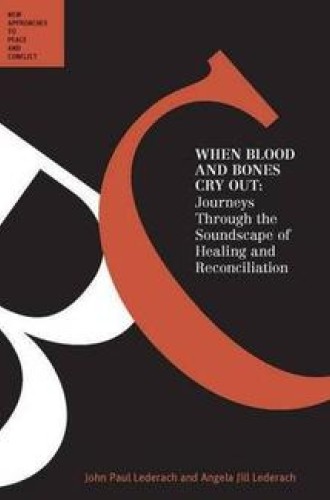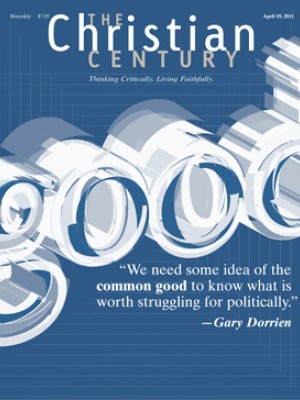When Blood and Bones Cry Out, by John Paul Lederach and Angela Jill Lederach
John Paul Lederach, practitioner and theorist of peace building, has grounded his work in stories and metaphor. Like a poet, he makes connections with fields and disciplines that are not normally connected in the literature of peace building, and he does so with the realism of a practitioner. In this book, he and his daughter, Angela Jill Lederach, have created an effective partnership. Together they explore social healing, primarily through the metaphor of sound.
"How do people express and then heal from violations that so destroy the essence of innocence, decency and life itself that the very experience penetrates beyond comprehension and words?" That is the question the book addresses. The authors challenge the dominant, linear metaphor of change, which suggests that healing occurs in stages—that it is experienced linearly and sequentially. For them, although there are patterns that seem to indicate phases and linear progression, the linear metaphor does not recognize that "change is a continuous flow of simultaneous, multilayered experience, not a sequential movement." The linear metaphor creates problems when it is imposed on a nonlinear reality, and there is no such thing as postviolence for many in the aftermath of war, especially women. "For women, violence does not end, nor does it decrease, after the signing of a peace accord. In the most disturbing of realities, peace keeping operations have actually resulted in an increase in sexual exploitation and prostitution, as well as HIV/AIDS."
Read our latest issue or browse back issues.
Metaphors matter! Metaphors are "deeply related to our ways of perceiving, understanding and interpreting the world." The Lederachs believe that a sonic metaphor, rather than a linear one, better describes the reality of social healing. The way to social healing is mixing voices where they can be heard and can thus develop vibration, resonance and social echo. These are qualities of sound. Sound evokes and "puts us in touch with aspects of our lives not easily expressed in words." Sound locates us and holds us as it surrounds us. Moreover, sound and music transport us to the "eternal now," where past, present and future come together—in both memory and hope.
The authors ground their thesis in and support it through stories: stories of child soldiers who are both victims and perpetrators, of the wandering elders of Somalia, of the disappeared in Colombia and of the women of Liberia who "danced, cried and sang their country back onto the long road toward healing." John Paul Lederach tells his own stories of experiencing music as grace and healing in life-threatening situations: the voice of Harry Emerson Fosdick's hymn "God of Grace and God of Glory," Bob Dylan's song "Tomorrow Is a Long Time" and the music of Van Morrison—"the inarticulate speech of the heart that he wanted his head to feel and his heart to speak."
At the heart of the book is the metaphor of the Tibetan singing bowl, which is used in Buddhist ceremonies calling people to meditation and to healing. The bowl is held in the flat of the palm of one hand. The other hand circles the rim with a leather- or felt-covered wooden stick. When the circling happens at the right pace, not too slowly or too rapidly, the motion creates friction and vibrations that ultimately find their natural frequency, and the bowl begins to sing. The sound rises up and out from the depth of the bowl, creating resonance and a social echo.
The Lederachs' analysis of the singing bowl as a metaphor is rich and generative. The bowl as a container shows the importance of the proximity of vibrations or voices to create resonance, to achieve the natural frequency. In peace building and social healing, this leads to a "preferential option for the local community" as the place where stories can be told and voices can be heard and mixed to find this limbic resonance. The container, the local community and the sounds surround and create a sensation of being touched and held.
Circling and repetition create the vibrations that find their natural frequency and become sound. Telling and retelling a story is important in therapy. It is also important in music: Gregorian chants, single-syllable Buddhist and Sanskrit mantras, West African djembe rhythms and Native American drum chants. Van Morrison's repetitions create a meditative space. Ritual is based on repetition, as seen in Holy Communion, for example. Repetition opens toward sacred connection—emphasizing depth and nurturing rather than distance, goals or an end product. For the Lederachs, this circling and repetition creates the experience of being surrounded by unconditional love.
The circling and repetition lead to resonance and social echo. Small resonances build to larger ones. The echoes are the ripples of felt vibrations that move out in a multidirectional way into the wider context. Social echo has the power to touch and impact both the micro (individual) and macro (larger communal) contexts of social healing. It moves outward and back. The Spanish word persona is related to the Latin sonare, which means to resonate with intensity. A person is a container that receives and holds the vibrations that make up sound in every cell of the body. We experience resonance at the deepest level of ourselves. Here we understand what it means to strike a chord and get in tune.
The Lederachs surmise that love may move in spatial and aural modalities, but they do not fully explore this motif, and I would have liked to hear more about the role of rhythm. As Grateful Dead drummer Mickey Hart once said, "Falling in love is falling in rhythm."
The authors also apply their sonic metaphor to the literal sense of displacement, insecurity and voicelessness experienced by victims of violence. Here place, safety and voice are discovered in their analysis of the Tibetan singing bowl. Constant nurturing is required as "sustainable reconciliation or healing is not sonically possible." The Lederachs also apply the sonic metaphor to the roles of poetry, drama and mothering.
When Blood and Bones Cry Out contains one of the best explanations of why the circle process has become so important in conflict transformation. The circle is a container for ritual, covenant and conversation. The talking piece allows for all the voices to be heard as it passes around the circle. The stories begin to connect, and natural frequencies are found that have resonance and sonic echo. What if churches, through their rituals and conversations, could develop such resonance and sonic echo? The Lederachs have given us a metaphoric gift that might have profound implications for the churches' role as places of social healing in our communities.






